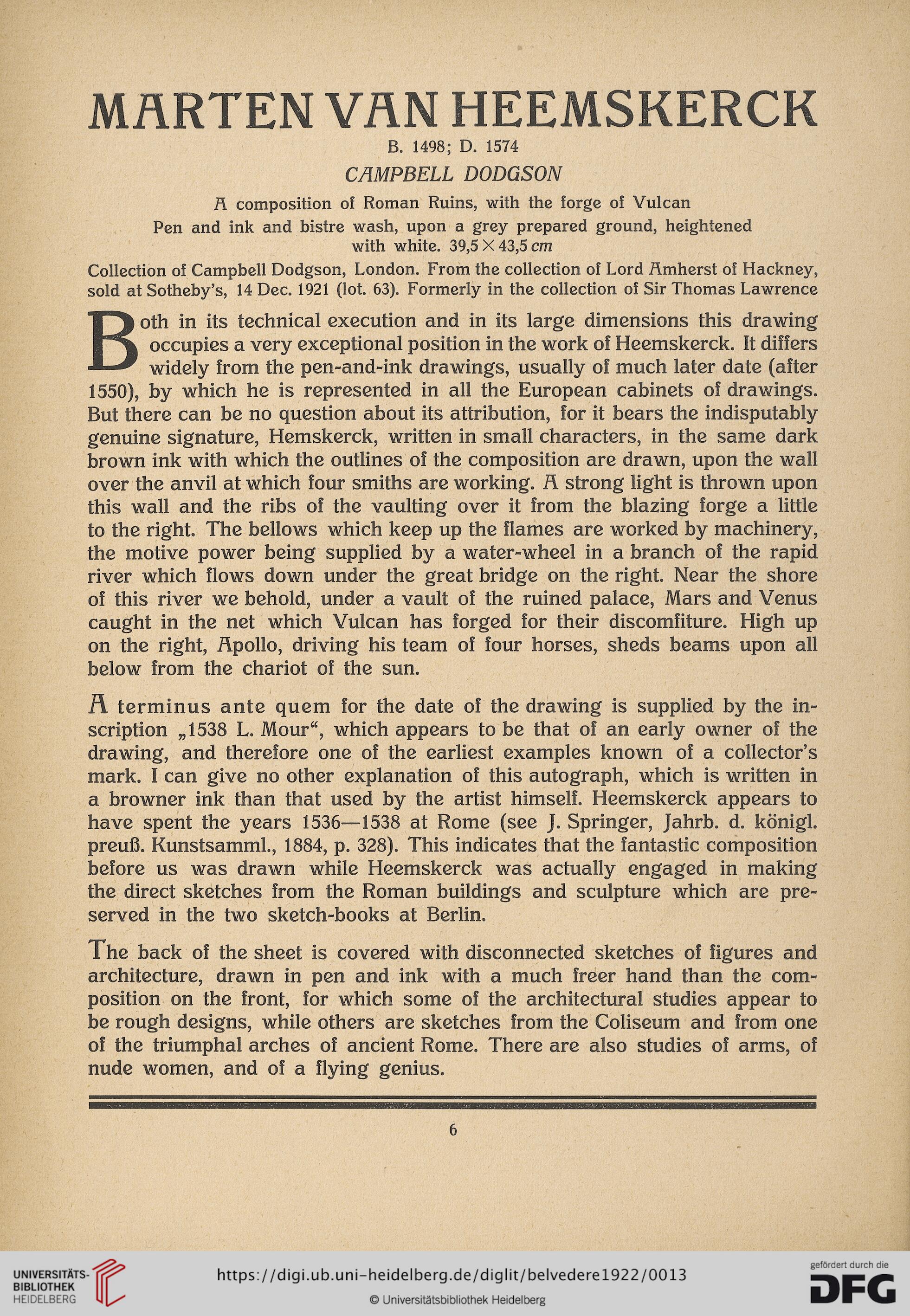MÄRTEN VÄN HEEMSKERCK
B. 1498; D. 1574
CAMPBELL DODGSON
Ä composition of Roman Ruins, with the forge of Vulcan
Pen and ink and bistre wash, upon a grey prepared ground, heightened
with white. 39,5X43,5 cm
Collection of Campbell Dodgson, London. From the collection of Lord Ämherst of Hackney,
sold at Sotheby’s, 14 Dec. 1921 (lot. 63). Formerly in the collection of Sir Thomas Lawrence
Both in its technical execution and in its large dimensions this drawing
occupies a very exceptional position in the work of Heemskerck. It differs
widely from the pen-and-ink drawings, usually of much later date (after
1550), by which he is represented in all the European cabinets of drawings.
But there can be no question about its attribution, for it bears the indisputably
genuine signature, Hemskerck, written in small characters, in the same dark
brown ink with which the outlines of the composition are drawn, upon the wall
over the anvil at which four smiths are working. A strong light is thrown upon
this wall and the ribs of the vaulting over it from the blazing forge a little
to the right. The bellows which keep up the flames are worked by machinery,
the motive power being supplied by a water-wheel in a branch of the rapid
river which flows down under the great bridge on the right. Near the shore
of this river we behold, under a vault of the ruined palace, Mars and Venus
caught in the net which Vulcan has forged for their discomfiture. High up
on the right, Apollo, driving his team of four horses, sheds beams upon all
below from the chariot of the sun.
A terminus ante quem for the date of the drawing is supplied by the in-
scription „1538 L. Mour“, which appears to be that of an early owner of the
drawing, and therefore one of the earliest examples known of a collector’s
mark. I can give no other explanation of this autograph, which is written in
a browner ink than that used by the artist himself. Heemskerck appears to
have spent the years 1536—1538 at Rome (see J. Springer, Jahrb. d. königl.
preuß. KunstsammL, 1884, p. 328). This indicates that the fantastic composition
before us was drawn while Heemskerck was actually engaged in making
the direct Sketches from the Roman buildings and sculpture which are pre-
served in the two sketch-books at Berlin.
The back of the sheet is covered with disconnected Sketches of figures and
architecture, drawn in pen and ink with a much freer hand than the com-
position on the front, for which some of the architectural studies appear to
be rough designs, while others are Sketches from the Coliseum and from one
of the triumphal arches of ancient Rome. There are also studies of arms, of
nude women, and of a flying genius.
»«w-w .".
6
B. 1498; D. 1574
CAMPBELL DODGSON
Ä composition of Roman Ruins, with the forge of Vulcan
Pen and ink and bistre wash, upon a grey prepared ground, heightened
with white. 39,5X43,5 cm
Collection of Campbell Dodgson, London. From the collection of Lord Ämherst of Hackney,
sold at Sotheby’s, 14 Dec. 1921 (lot. 63). Formerly in the collection of Sir Thomas Lawrence
Both in its technical execution and in its large dimensions this drawing
occupies a very exceptional position in the work of Heemskerck. It differs
widely from the pen-and-ink drawings, usually of much later date (after
1550), by which he is represented in all the European cabinets of drawings.
But there can be no question about its attribution, for it bears the indisputably
genuine signature, Hemskerck, written in small characters, in the same dark
brown ink with which the outlines of the composition are drawn, upon the wall
over the anvil at which four smiths are working. A strong light is thrown upon
this wall and the ribs of the vaulting over it from the blazing forge a little
to the right. The bellows which keep up the flames are worked by machinery,
the motive power being supplied by a water-wheel in a branch of the rapid
river which flows down under the great bridge on the right. Near the shore
of this river we behold, under a vault of the ruined palace, Mars and Venus
caught in the net which Vulcan has forged for their discomfiture. High up
on the right, Apollo, driving his team of four horses, sheds beams upon all
below from the chariot of the sun.
A terminus ante quem for the date of the drawing is supplied by the in-
scription „1538 L. Mour“, which appears to be that of an early owner of the
drawing, and therefore one of the earliest examples known of a collector’s
mark. I can give no other explanation of this autograph, which is written in
a browner ink than that used by the artist himself. Heemskerck appears to
have spent the years 1536—1538 at Rome (see J. Springer, Jahrb. d. königl.
preuß. KunstsammL, 1884, p. 328). This indicates that the fantastic composition
before us was drawn while Heemskerck was actually engaged in making
the direct Sketches from the Roman buildings and sculpture which are pre-
served in the two sketch-books at Berlin.
The back of the sheet is covered with disconnected Sketches of figures and
architecture, drawn in pen and ink with a much freer hand than the com-
position on the front, for which some of the architectural studies appear to
be rough designs, while others are Sketches from the Coliseum and from one
of the triumphal arches of ancient Rome. There are also studies of arms, of
nude women, and of a flying genius.
»«w-w .".
6




